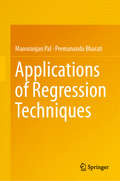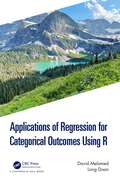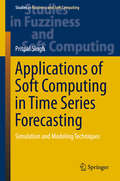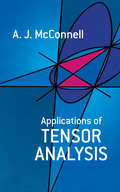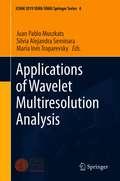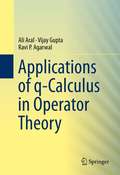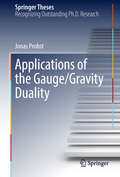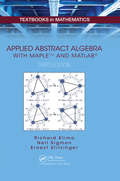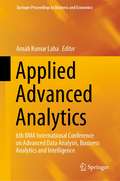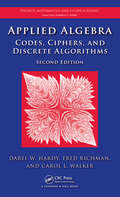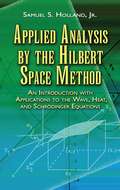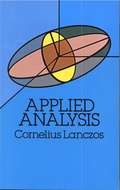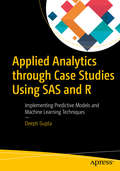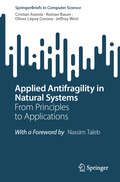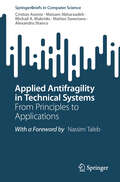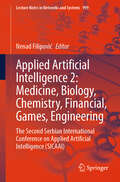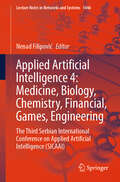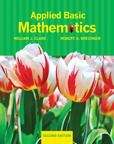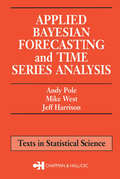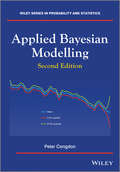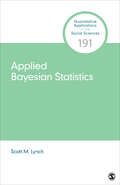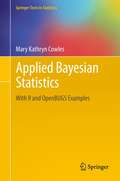- Table View
- List View
Applications of Regression Techniques
by Manoranjan Pal Premananda BharatiThis book discusses the need to carefully and prudently apply various regression techniques in order to obtain the full benefits. It also describes some of the techniques developed and used by the authors, presenting their innovative ideas regarding the formulation and estimation of regression decomposition models, hidden Markov chain, and the contribution of regressors in the set-theoretic approach, calorie poverty rate, and aggregate growth rate. Each of these techniques has applications that address a number of unanswered questions; for example, regression decomposition techniques reveal intra-household gender inequalities of consumption, intra-household allocation of resources and adult equivalent scales, while Hidden Markov chain models can forecast the results of future elections. Most of these procedures are presented using real-world data, and the techniques can be applied in other similar situations. Showing how difficult questions can be answered by developing simple models with simple interpretation of parameters, the book is a valuable resource for students and researchers in the field of model building.
Applications of Regression for Categorical Outcomes Using R
by David Melamed Long DoanThis book covers the main models within the GLM (i.e., logistic, Poisson, negative binomial, ordinal, and multinomial). For each model, estimations, interpretations, model fit, diagnostics, and how to convey results graphically are provided. There is a focus on graphic displays of results as these are a core strength of using R for statistical analysis. Many in the social sciences are transitioning away from using Stata, SPSS and SAS, to using R, and this book uses statistical models which are relevant to the social sciences. Social Science Applications of Regression for Categorical Outcomes Using R will be useful for graduate students in the social sciences who are looking to expand their statistical knowledge, and for Quantitative social scientists due to it’s ability to act as a practitioners guide. Key Features: Applied- in the sense that we will provide code that others can easily adapt Flexible- R is basically just a fancy calculator. Our programs will enable users to derive quantities that they can use in their work Timely- many in the social sciences are currently transitioning to R or are learning it now. Our book will be a useful resource Versatile- we will write functions into an R package that can be applied to all of the regression models we will cover in the book Aesthetically pleasing- one advantage of R relative to other software packages is that graphs are fully customizable. We will leverage this feature to yield high-end graphical displays of results Affordability- R is free. R packages are free. There is no need to purchase site licenses or updates.
Applications of Soft Computing in Time Series Forecasting: Simulation and Modeling Techniques (Studies in Fuzziness and Soft Computing #330)
by Pritpal SinghThis book reports on an in-depth study of fuzzy time series (FTS) modeling. It reviews and summarizes previous research work in FTS modeling and also provides a brief introduction to other soft-computing techniques, such as artificial neural networks (ANNs), rough sets (RS) and evolutionary computing (EC), focusing on how these techniques can be integrated into different phases of the FTS modeling approach. In particular, the book describes novel methods resulting from the hybridization of FTS modeling approaches with neural networks and particle swarm optimization. It also demonstrates how a new ANN-based model can be successfully applied in the context of predicting Indian summer monsoon rainfall. Thanks to its easy-to-read style and the clear explanations of the models, the book can be used as a concise yet comprehensive reference guide to fuzzy time series modeling, and will be valuable not only for graduate students, but also for researchers and professionals working for academic, business and government organizations.
Applications of Tensor Analysis (Dover Books on Mathematics)
by A. J. McConnellThis standard work applies tensorial methods to subjects within the realm of advanced college mathematics. In its four main divisions, it explains the fundamental ideas and the notation of tensor theory; covers the geometrical treatment of tensor algebra; introduces the theory of the differentiation of tensors; and applies mathematics to dynamics, electricity, elasticity, and hydrodynamics.Partial contents: algebraic preliminaries (notation, definitions, determinants, tensor analysis); algebraic geometry (rectilinear coordinates, the plane, the straight line, the quadric cone and the conic, systems of cones and conics, central quadrics, the general quadric, affine transformations); differential geometry (curvilinear coordinates, covariant differentiation, curves in a space, intrinsic geometry of a surface, fundamental formulae of a surface, curves on a surface); applied mathematics (dynamics of a particles, dynamics of rigid bodies, electricity and magnetism, mechanics of continuous media, special theory of relativity).
Applications of Wavelet Multiresolution Analysis (SEMA SIMAI Springer Series #4)
by Juan Pablo Muszkats Silvia Alejandra Seminara María Inés TroparevskyThis work results from a selection of the contributions presented in the mini symposium “Applications of Multiresolution Analysis with “Wavelets”, presented at the ICIAM 19, the International Congress on Industrial and Applied Mathematics held at Valencia, Spain, in July 2019. The presented developments and applications cover different areas, including filtering, signal analysis for damage detection, time series analysis, solutions to boundary value problems and fractional calculus. This bunch of examples highlights the importance of multiresolution analysis to face problems in several and varied disciplines. The book is addressed to researchers in the field.
Applications of q-Calculus in Operator Theory
by Ravi P Agarwal Ali Aral Vijay GuptaThe approximation of functions by linear positive operators is an important research topic in general mathematics and it also provides powerful tools to application areas such as computer-aided geometric design, numerical analysis, and solutions of differential equations. q-Calculus is a generalization of many subjects, such as hypergeometric series, complex analysis, and particle physics. This monograph is an introduction to combining approximation theory and q-Calculus with applications, by using well- known operators. The presentation is systematic and the authors include a brief summary of the notations and basic definitions of q-calculus before delving into more advanced material. The many applications of q-calculus in the theory of approximation, especially on various operators, which includes convergence of operators to functions in real and complex domain forms the gist of the book. This book is suitable for researchers and students in mathematics, physics and engineering, and for professionals who would enjoy exploring the host of mathematical techniques and ideas that are collected and discussed in the book.
Applications of the Gauge/Gravity Duality (Springer Theses)
by Jonas ProbstMany open questions in Theoretical Physics pertain to strongly interacting quantum systems such as the quark-gluon plasma (QGP) produced in heavy-ion collisions or the strange-metal phase observed in many high-temperature superconductors. These systems are notoriously difficult to study using traditional methods such as perturbation theory, but the gauge/gravity duality offers a successful alternative approach, which maps strongly interacting quantum gauge theories to computationally tractable, classical gravity theories. This book begins with a pedagogical introduction to how the duality can be used to extract transport properties of quantum systems from their gravity dual. It then presents new results on hydrodynamic transport in strongly interacting quantum fluids, providing strong evidence that the Haack-Yarom identity between second-order transport coefficients holds for all fluids with a classical gravity dual and may be a universal feature of all strongly coupled quantum fluids such as the QGP. Newly derived Kubo formulae, expressing transport coefficients in terms of quantum correlators, hold independently of the duality. Lastly, the book discusses new results on magnetic impurities in strongly correlated metals, including the first dual gravity description of an inter-impurity coupling, crucial for the quantum criticality underlying the strange-metal phase.
Applied Abstract Algebra with MapleTM and MATLAB: A Maple And Matlab Approach
by Richard Klima Neil Sigmon Ernest StitzingerApplied Abstract Algebra with MapleTM and MATLAB provides an in-depth introduction to real-world abstract algebraic problems. This popular textbook covers a variety of topics including block designs, coding theory, cryptography, and counting techniques, including Polya's and Burnside's theorems. The book also includes a concise review of all prereq
Applied Advanced Analytics: 6th IIMA International Conference on Advanced Data Analysis, Business Analytics and Intelligence (Springer Proceedings in Business and Economics)
by Arnab Kumar LahaThis book covers several new areas in the growing field of analytics with some innovative applications in different business contexts, and consists of selected presentations at the 6th IIMA International Conference on Advanced Data Analysis, Business Analytics and Intelligence. The book is conceptually divided in seven parts. The first part gives expository briefs on some topics of current academic and practitioner interests, such as data streams, binary prediction and reliability shock models. In the second part, the contributions look at artificial intelligence applications with chapters related to explainable AI, personalized search and recommendation, and customer retention management. The third part deals with credit risk analytics, with chapters on optimization of credit limits and mitigation of agricultural lending risks. In its fourth part, the book explores analytics and data mining in the retail context. In the fifth part, the book presents some applications of analytics to operations management. This part has chapters related to improvement of furnace operations, forecasting food indices and analytics for improving student learning outcomes. The sixth part has contributions related to adaptive designs in clinical trials, stochastic comparisons of systems with heterogeneous components and stacking of models. The seventh and final part contains chapters related to finance and economics topics, such as role of infrastructure and taxation on economic growth of countries and connectedness of markets with heterogenous agents, The different themes ensure that the book would be of great value to practitioners, post-graduate students, research scholars and faculty teaching advanced business analytics courses.
Applied Algebra and Number Theory
by Gerhard Larcher Friedrich Pillichshammer Arne Winterhof Chaoping XingHarald Niederreiter's pioneering research in the field of applied algebra and number theory has led to important and substantial breakthroughs in many areas. This collection of survey articles has been authored by close colleagues and leading experts to mark the occasion of his 70th birthday. The book provides a modern overview of different research areas, covering uniform distribution and quasi-Monte Carlo methods as well as finite fields and their applications, in particular, cryptography and pseudorandom number generation. Many results are published here for the first time. The book serves as a useful starting point for graduate students new to these areas or as a refresher for researchers wanting to follow recent trends.
Applied Algebra: Codes, Ciphers and Discrete Algorithms, Second Edition (Discrete Mathematics and Its Applications)
by Darel W. Hardy Fred Richman Carol L. WalkerUsing mathematical tools from number theory and finite fields, Applied Algebra: Codes, Ciphers, and Discrete Algorithms, Second Edition presents practical methods for solving problems in data security and data integrity. It is designed for an applied algebra course for students who have had prior classes in abstract or linear algebra. While the content has been reworked and improved, this edition continues to cover many algorithms that arise in cryptography and error-control codes. New to the Second Edition Downloadable resources containing an interactive version of the book that is powered by Scientific Notebook®, a mathematical word processor and easy-to-use computer algebra system New appendix that reviews prerequisite topics in algebra and number theory Double the number of exercises Instead of a general study on finite groups, the book considers finite groups of permutations and develops just enough of the theory of finite fields to facilitate construction of the fields used for error-control codes and the Advanced Encryption Standard. It also deals with integers and polynomials. Explaining the mathematics as needed, this text thoroughly explores how mathematical techniques can be used to solve practical problems. About the AuthorsDarel W. Hardy is Professor Emeritus in the Department of Mathematics at Colorado State University. His research interests include applied algebra and semigroups.Fred Richman is a professor in the Department of Mathematical Sciences at Florida Atlantic University. His research interests include Abelian group theory and constructive mathematics.Carol L. Walker is Associate Dean Emeritus in the Department of Mathematical Sciences at New Mexico State University. Her research interests include Abelian group theory, applications of homological algebra and category theory, and the mathematics of fuzzy sets and fuzzy logic.
Applied Analysis by the Hilbert Space Method: An Introduction with Applications to the Wave, Heat, and Schrödinger Equations
by Samuel S. Holland Jr.Numerous worked examples and exercises highlight this unified treatment of the Hermitian operator theory in its Hilbert space setting. Its simple explanations of difficult subjects make it accessible to undergraduates as well as an ideal self-study guide.Featuring full discussions of first and second order linear differential equations, the text introduces the fundamentals of Hilbert space theory and Hermitian differential operators. It derives the eigenvalues and eigenfunctions of classical Hermitian differential operators, develops the general theory of orthogonal bases in Hilbert space, and offers a comprehensive account of Schrödinger's equations. In addition, it surveys the Fourier transform as a unitary operator and demonstrates the use of various differentiation and integration techniques.Samuel S. Holland, Jr. is a professor of mathematics at the University of Massachusetts, Amherst. He has kept this text accessible to undergraduates by omitting proofs of some theorems but maintaining the core ideas of crucially important results. Intuitively appealing to students in applied mathematics, physics, and engineering, this volume is also a fine reference for applied mathematicians, physicists, and theoretical engineers.
Applied Analysis: Prentice Hall Mathematics Series (Dover Books on Mathematics)
by Cornelius LanczosThis is a basic text for graduate and advanced undergraduate study in those areas of mathematical analysis that are of primary concern to the engineer and the physicist, most particularly analysis and design of finite processes that approximate the solution of an analytical problem. The work comprises seven chapters:Chapter I (Algebraic Equations) deals with the search for roots of algebraic equations encountered in vibration and flutter problems and in those of static and dynamic stability. Useful computing techniques are discussed, in particular the Bernoulli method and its ramifications.Chapter II (Matrices and Eigenvalue Problems) is devoted to a systematic development of the properties of matrices, especially in the context of industrial research.Chapter III (Large-Scale Linear Systems) discusses the "spectroscopic method" of finding the real eigenvalues of large matrices and the corresponding method of solving large-scale linear equations as well as an additional treatment of a perturbation problem and other topics.Chapter IV (Harmonic Analysis) deals primarily with the interpolation aspects of the Fourier series and its flexibility in representing empirically given equidistant data.Chapter V (Data Analysis) deals with the problem of reduction of data and of obtaining the first and even second derivatives of an empirically given function — constantly encountered in tracking problems in curve-fitting problems. Two methods of smoothing are discussed: smoothing in the small and smoothing in the large.Chapter VI (Quadrature Methods) surveys a variety of quadrature methods with particular emphasis on Gaussian quadrature and its use in solving boundary value problems and eignenvalue problems associated with ordinary differential equations.Chapter VII (Power Expansions) discusses the theory of orthogonal function systems, in particular the "Chebyshev polynomials."This unique work, perennially in demand, belongs in the library of every engineer, physicist, or scientist interested in the application of mathematical analysis to engineering, physical, and other practical problems.
Applied Analytics through Case Studies Using SAS and R: Implementing Predictive Models and Machine Learning Techniques
by Deepti GuptaExamine business problems and use a practical analytical approach to solve them by implementing predictive models and machine learning techniques using SAS and the R analytical language. This book is ideal for those who are well-versed in writing code and have a basic understanding of statistics, but have limited experience in implementing predictive models and machine learning techniques for analyzing real world data. The most challenging part of solving industrial business problems is the practical and hands-on knowledge of building and deploying advanced predictive models and machine learning algorithms. Applied Analytics through Case Studies Using SAS and R is your answer to solving these business problems by sharpening your analytical skills. What You'll Learn Understand analytics and basic data concepts Use an analytical approach to solve Industrial business problems Build predictive model with machine learning techniquesCreate and apply analytical strategiesWho This Book Is ForData scientists, developers, statisticians, engineers, and research students with a great theoretical understanding of data and statistics who would like to enhance their skills by getting practical exposure in data modeling.
Applied Antifragility in Natural Systems: From Principles to Applications (SpringerBriefs in Computer Science)
by Roman Bauer Cristian Axenie Oliver López Corona Jeffrey WestAs coined in the book of Nassim Taleb, antifragility is a property of a system to gain from uncertainty, randomness, and volatility, opposite to what fragility would incur. An antifragile system’s response to external perturbations is beyond robust, such that small stressors can strengthen the future response of the system by adding a strong anticipation component. Such principles are already well suited for describing behaviors in natural systems but also in approaching therapy designs and eco-system modelling and eco-system analysis. The purpose of this book is to build a foundational knowledge base by applying antifragile system design, analysis, and development in natural systems, including biomedicine, neuroscience, and ecology as main fields. We are interested in formalizing principles and an apparatus that turns the basic concept of antifragility into a tool for designing and building closed-loop systems that behave beyond robust in the face of uncertainty when characterizing and intervening in biomedical and ecological (eco)systems. The book introduces the framework of applied antifragility and possible paths to build systems that gain from uncertainty. We draw from the body of literature on natural systems (e.g. cancer therapy, antibiotics, neuroscience, and agricultural pest management) in an attempt to unify the scales of antifragility in one framework. The work of the Applied Antifragility Group in oncology, neuroscience, and ecology led by the authors provides a good overview on the current research status.
Applied Antifragility in Technical Systems: From Principles to Applications (SpringerBriefs in Computer Science)
by Matteo Saveriano Cristian Axenie Meisam Akbarzadeh Michail A. Makridis Alexandru StancuThe book purpose is to build a foundational knowledge base by applying antifragile system design, analysis, and development in technical systems, with a focus on traffic engineering, robotics, and control engineering. The authors are interested in formalizing principles and an apparatus that turns the basic concept of antifragility into a tool for designing and building closed-loop technical systems that behave beyond robust in the face of uncertainty. As coined in the book of Nassim Taleb, antifragility is a property of a system to gain from uncertainty, randomness, and volatility, opposite to what fragility would incur. An antifragile system’s response to external perturbations is beyond robust, such that small stressors can strengthen the future response of the system by adding a strong anticipation component. The work of the Applied Antifragility Group in traffic control and robotics, led by the authors, provides a good overview on the current research status.
Applied Artificial Intelligence 2: The Second Serbian International Conference on Applied Artificial Intelligence (SICAAI) (Lecture Notes in Networks and Systems #999)
by Nenad FilipovićThe book Applied Artificial Intelligence 2: Medicine, Biology, Chemistry, Financial, Games, Engineering is providing exceptional chapters of the state-of-the-art research knowledge and results on the innovative theories, methodology and applications of artificial intelligence and its sub-domain like deep learning, machine learning in different areas such as medicine, economy, education, law, smart city, government, industry etc. Innovative research ideas on how to solve problems using artificial intelligence, both in R&D and real-time applications are presented. Chapters describe the advanced prototypes, systems, methodologies, tools and techniques and general survey papers, which indicate future directions. These Chapters are extended papers from the Second Serbian International Conference on Applied Artificial Intelligence (SICAAI), which was held in Kragujevac, Serbia, on May 19-20, 2023
Applied Artificial Intelligence 4: The Third Serbian International Conference on Applied Artificial Intelligence (SICAAI) (Lecture Notes in Networks and Systems #1446)
by Nenad FilipovićThe book covers the state-of-the-art research knowledge and results on the innovative theories, methodology and applications of artificial intelligence and its sub-domain like deep learning in different areas such as medicine, economy, education, law, smart city, government, industry etc. Moreover, the book aims to provide a platform for researchers and practitioners for both academia and industry to share the information about cutting-edge developments in the field of artificial intelligence. The chapters in this book integrated approach toward global exchange of information on technological advances, scientific innovations and the effectiveness of various regulatory programs toward AI application in medicine, biology, chemistry, financial, games, law and engineering. Real examples from academia and industry give beyond state of the art for application of AI in different areas. These chapters are extended papers from the Third Serbian International Conference on Applied Artificial Intelligence (SICAAI), which was held in Kragujevac, Serbia, on May 23–24, 2024.
Applied Basic Mathematics
by William Clark Robert A. BrechnerWith an emphasis on real world applications, Applied Basic Mathematics, Second Edition, provides students with a new and refreshing perspective on basic math. Paired with a system of structured support, authors Clark and Brechner consistently asks student to relate, reinforce, and review as they learn. This text provides professors with a dynamic way of teaching the material and an approach that encourages students to dive into the math!
Applied Bayesian Forecasting and Time Series Analysis
by Andy Pole Mike West Jeff HarrisonPractical in its approach, Applied Bayesian Forecasting and Time Series Analysis provides the theories, methods, and tools necessary for forecasting and the analysis of time series. The authors unify the concepts, model forms, and modeling requirements within the framework of the dynamic linear mode (DLM). They include a complete theoretical development of the DLM and illustrate each step with analysis of time series data. Using real data sets the authors: Explore diverse aspects of time series, including how to identify, structure, explain observed behavior, model structures and behaviors, and interpret analyses to make informed forecasts Illustrate concepts such as component decomposition, fundamental model forms including trends and cycles, and practical modeling requirements for routine change and unusual events Conduct all analyses in the BATS computer programs, furnishing online that program and the more than 50 data sets used in the text The result is a clear presentation of the Bayesian paradigm: quantified subjective judgements derived from selected models applied to time series observations. Accessible to undergraduates, this unique volume also offers complete guidelines valuable to researchers, practitioners, and advanced students in statistics, operations research, and engineering.
Applied Bayesian Modelling
by Peter CongdonThis book provides an accessible approach to Bayesian computing and data analysis, with an emphasis on the interpretation of real data sets. Following in the tradition of the successful first edition, this book aims to make a wide range of statistical modeling applications accessible using tested code that can be readily adapted to the reader's own applications. The second edition has been thoroughly reworked and updated to take account of advances in the field. A new set of worked examples is included. The novel aspect of the first edition was the coverage of statistical modeling using WinBUGS and OPENBUGS. This feature continues in the new edition along with examples using R to broaden appeal and for completeness of coverage.
Applied Bayesian Statistics (Quantitative Applications in the Social Sciences)
by Scott M. LynchBayesian statistical analyses have become increasingly common over the last two decades. The rapid increase in computing power that facilitated their implementation coincided with major changes in the research interests of, and data availability for, social scientists. Specifically, the last two decades have seen an increase in the availability of panel data sets, other hierarchically structured data sets including spatially organized data, along with interests in life course processes and the influence of context on individual behavior and outcomes. The Bayesian approach to statistics is well-suited for these types of data and research questions. Applied Bayesian Statistics is an introduction to these methods that is geared toward social scientists. Author Scott M. Lynch makes the material accessible by emphasizing application more than theory, explaining the math in a step-by-step fashion, and demonstrating the Bayesian approach in analyses of U.S. political trends drawing on data from the General Social Survey.
Applied Bayesian Statistics (Quantitative Applications in the Social Sciences)
by Scott M. LynchBayesian statistical analyses have become increasingly common over the last two decades. The rapid increase in computing power that facilitated their implementation coincided with major changes in the research interests of, and data availability for, social scientists. Specifically, the last two decades have seen an increase in the availability of panel data sets, other hierarchically structured data sets including spatially organized data, along with interests in life course processes and the influence of context on individual behavior and outcomes. The Bayesian approach to statistics is well-suited for these types of data and research questions. Applied Bayesian Statistics is an introduction to these methods that is geared toward social scientists. Author Scott M. Lynch makes the material accessible by emphasizing application more than theory, explaining the math in a step-by-step fashion, and demonstrating the Bayesian approach in analyses of U.S. political trends drawing on data from the General Social Survey.
Applied Bayesian Statistics: With R and OpenBUGS Examples (Springer Texts in Statistics #98)
by Mary Kathryn CowlesThis book is based on over a dozen years teaching a Bayesian Statistics course. The material presented here has been used by students of different levels and disciplines, including advanced undergraduates studying Mathematics and Statistics and students in graduate programs in Statistics, Biostatistics, Engineering, Economics, Marketing, Pharmacy, and Psychology. The goal of the book is to impart the basics of designing and carrying out Bayesian analyses, and interpreting and communicating the results. In addition, readers will learn to use the predominant software for Bayesian model-fitting, R and OpenBUGS. The practical approach this book takes will help students of all levels to build understanding of the concepts and procedures required to answer real questions by performing Bayesian analysis of real data. Topics covered include comparing and contrasting Bayesian and classical methods, specifying hierarchical models, and assessing Markov chain Monte Carlo output. Kate Cowles taught Suzuki piano for many years before going to graduate school in Biostatistics. Her research areas are Bayesian and computational statistics, with application to environmental science. She is on the faculty of Statistics at The University of Iowa.
Applied Biclustering Methods for Big and High-Dimensional Data Using R (Chapman & Hall/CRC Biostatistics Series)
by Ziv Shkedy Sebastian Kaiser Adetayo Kasim Sepp Hochreiter Willem TalloenProven Methods for Big Data Analysis As big data has become standard in many application areas, challenges have arisen related to methodology and software development, including how to discover meaningful patterns in the vast amounts of data. Addressing these problems, Applied Biclustering Methods for Big and High-Dimensional Data Using R shows how to apply biclustering methods to find local patterns in a big data matrix.The book presents an overview of data analysis using biclustering methods from a practical point of view. Real case studies in drug discovery, genetics, marketing research, biology, toxicity, and sports illustrate the use of several biclustering methods. References to technical details of the methods are provided for readers who wish to investigate the full theoretical background. All the methods are accompanied with R examples that show how to conduct the analyses. The examples, software, and other materials are available on a supplementary website.
